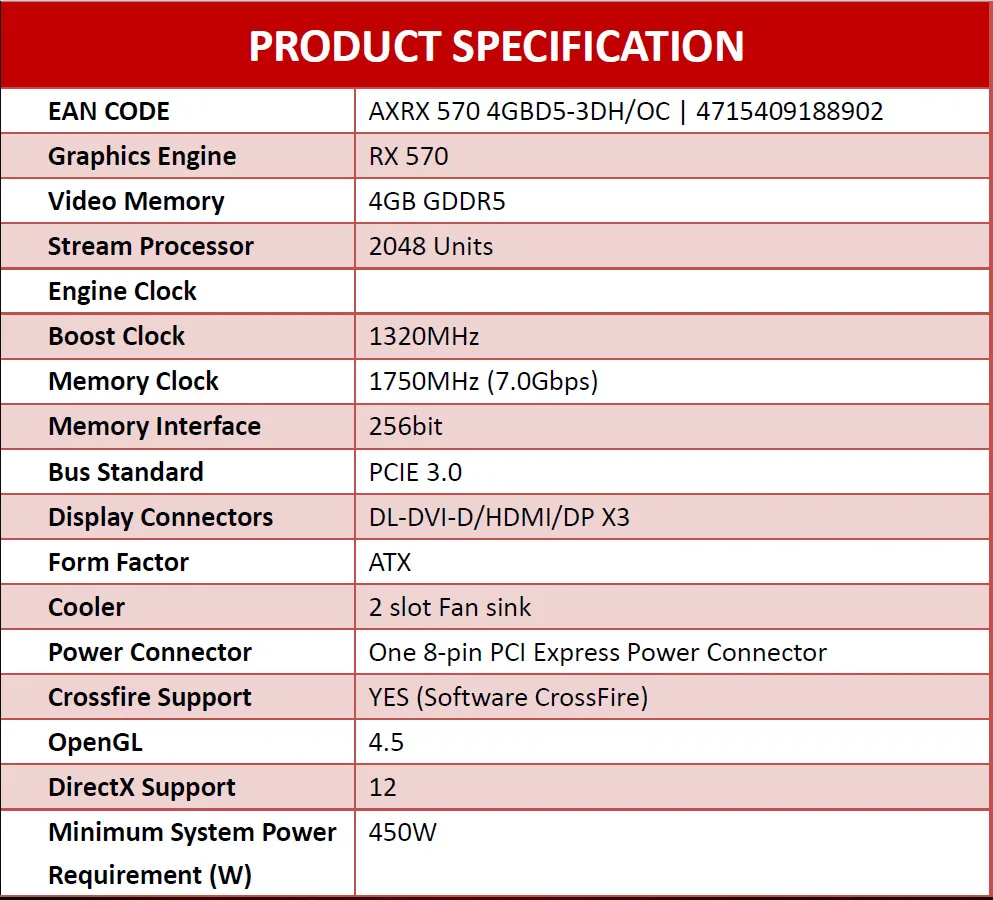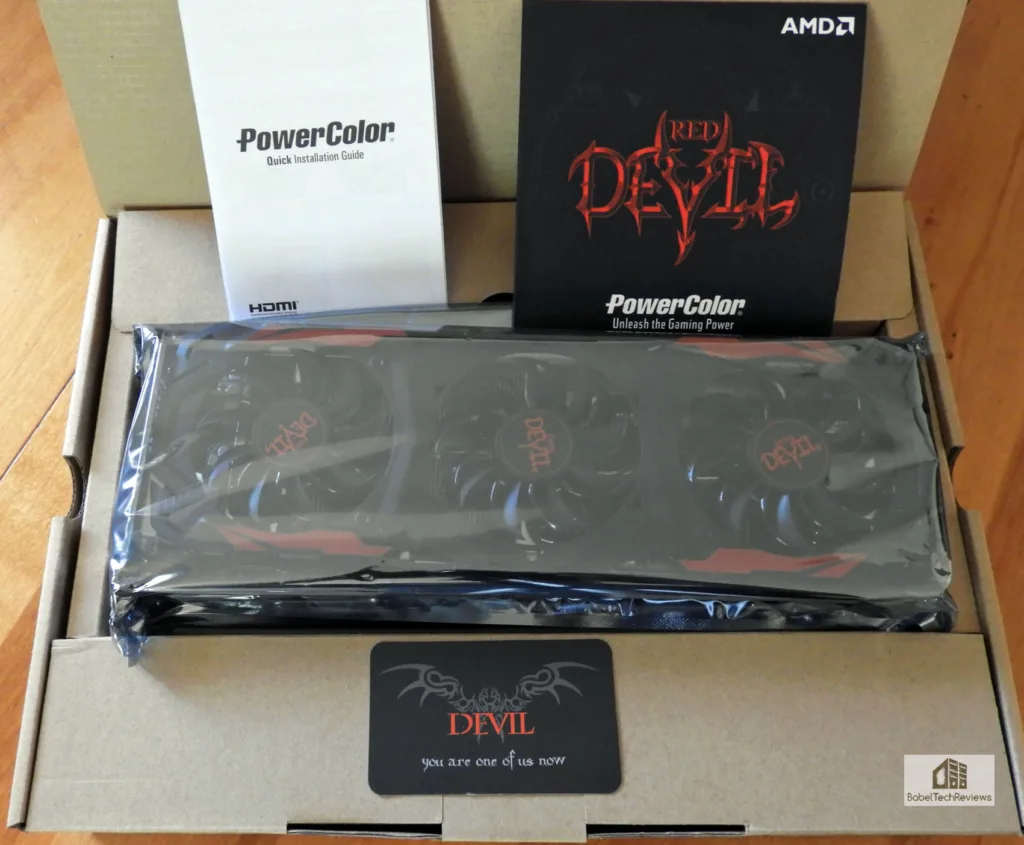The RX 570 arrived last week at BTR for evaluation as a 4GB Red Devil video card from PowerColor priced at $189.99 and we have been benching it versus the PowerColor Red Devil RX 470 and versus the stock EVGA GTX 1060 3GB video card using 26 games and 4 synthetic benchmarks.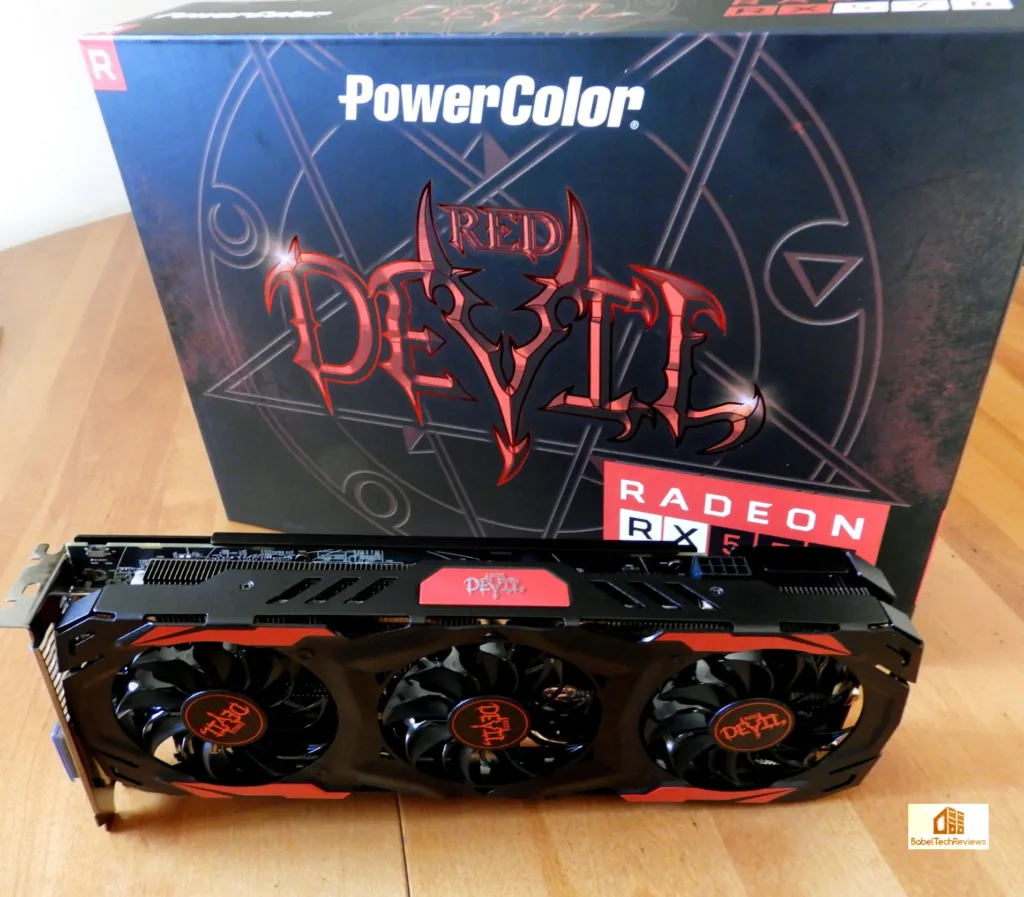 Although, the Red Devil RX 570 is a refresh or rebrand of the Red Devil RX 470 with a mild +50MHz overclock to the core and the same 1750MHz memory speeds, the card has drastically altered its form – from a relatively small dual fan card to a much larger triple fan card.
Although, the Red Devil RX 570 is a refresh or rebrand of the Red Devil RX 470 with a mild +50MHz overclock to the core and the same 1750MHz memory speeds, the card has drastically altered its form – from a relatively small dual fan card to a much larger triple fan card.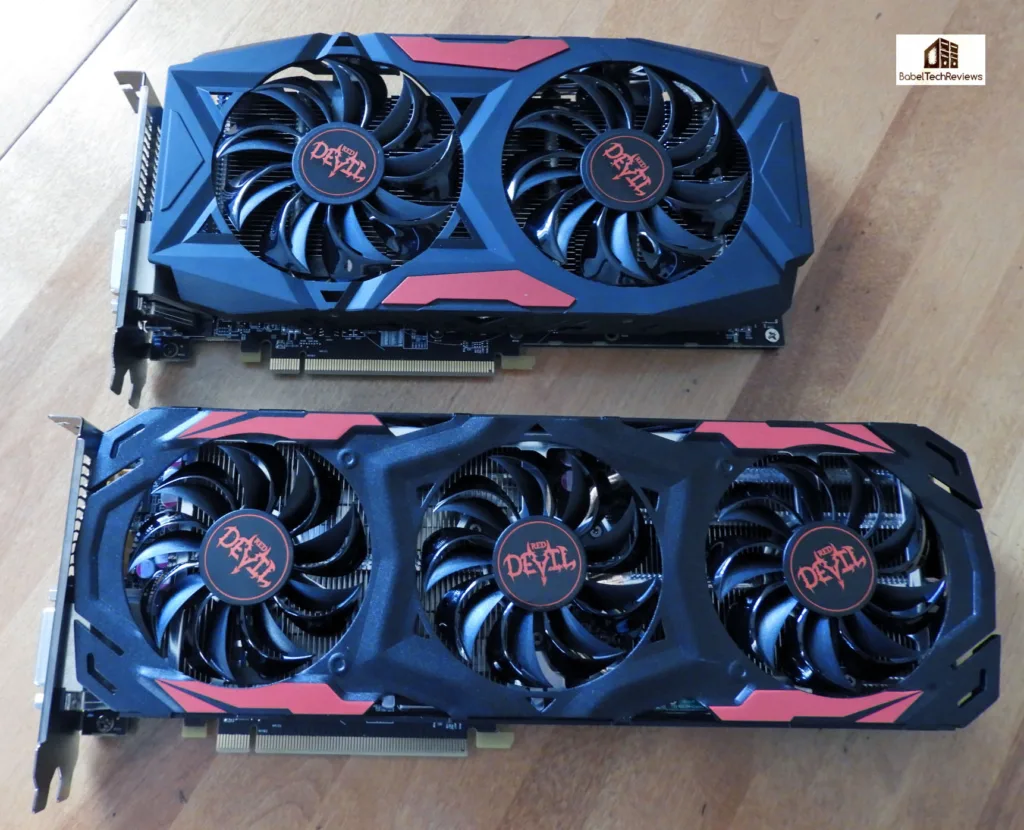
AMD released its Polaris architecture as the RX 480 on June 29, 2016. We saw that even though it launched on immature drivers and with power issues, it is fairly well-suited for bringing less expensive VR to the masses as AMD claims. We followed its progress with improved drivers that somewhat addressed the power issues, and we also saw that it was only a fair overclocker versus the GTX 1060. We also benchmarked the PowerColor RX 470 in a series of reviews versus the GTX 1060 3GB card which culminated in an overclocking showdown that the NVIDIA card easily won.
Now we have a brand new card released today, the RX 570, in the form of the PowerColor Red Devil that we will benchmark at PowerColor Red Devil reference RX 570 speeds against the PowerColor Red Devil reference RX 470 to see how it compares in performance. And we will also benchmark the only other other competing NVIDIA card in a similar price range – the GTX 1060 3GB – to see where the new RX 570 stands regarding price versus performance.
Both the PowerColor Red Devil RX 470 and RX 570 use a single 8-pin PCIe cable versus the 6-pin power connector in the reference RX 470 and RX 480. And we saw the original reference RX 480 get into trouble with its 6-pin connector as being insufficient for overclocking. Having 8-pin power connectors, both the Red Devil RX 470 and the RX 570 are designed for superior performance, overclocking, and more stable power.
Let’s take a brief look at the specifications of the PowerColor Red Devil RX 470 versus the PowerColor Red Devil RX 570.
The Red Devil RX 470 4GB vs. the Red Devil RX 570 4GB
First, here are the specifications for the Red Devil RX 470 which launched last year for $199: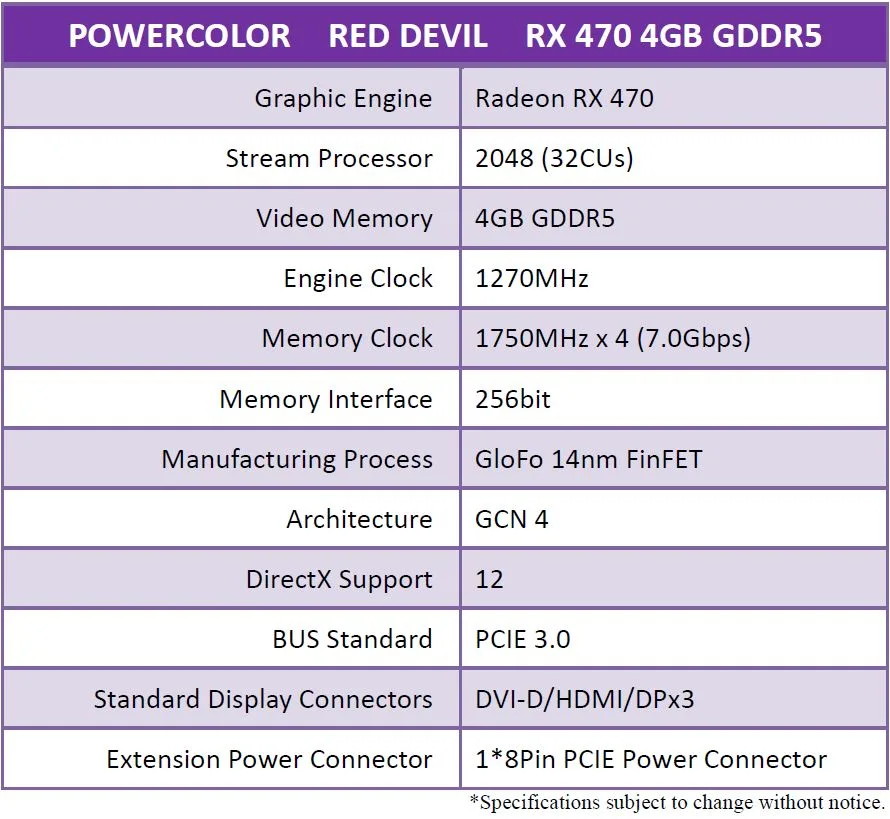
Now here are the specifications for the $189 PowerColor Red Devil RX 570:
As we can see, the only upgrade to the specifications of the PowerColor Red Devil RX 470 to the Red Devil RX 570 is a 50MHz increase to the Boost clock from the RX 470’s 1270MHz to the RX 570’s 1320MHz.
Our Testbed of Competing Cards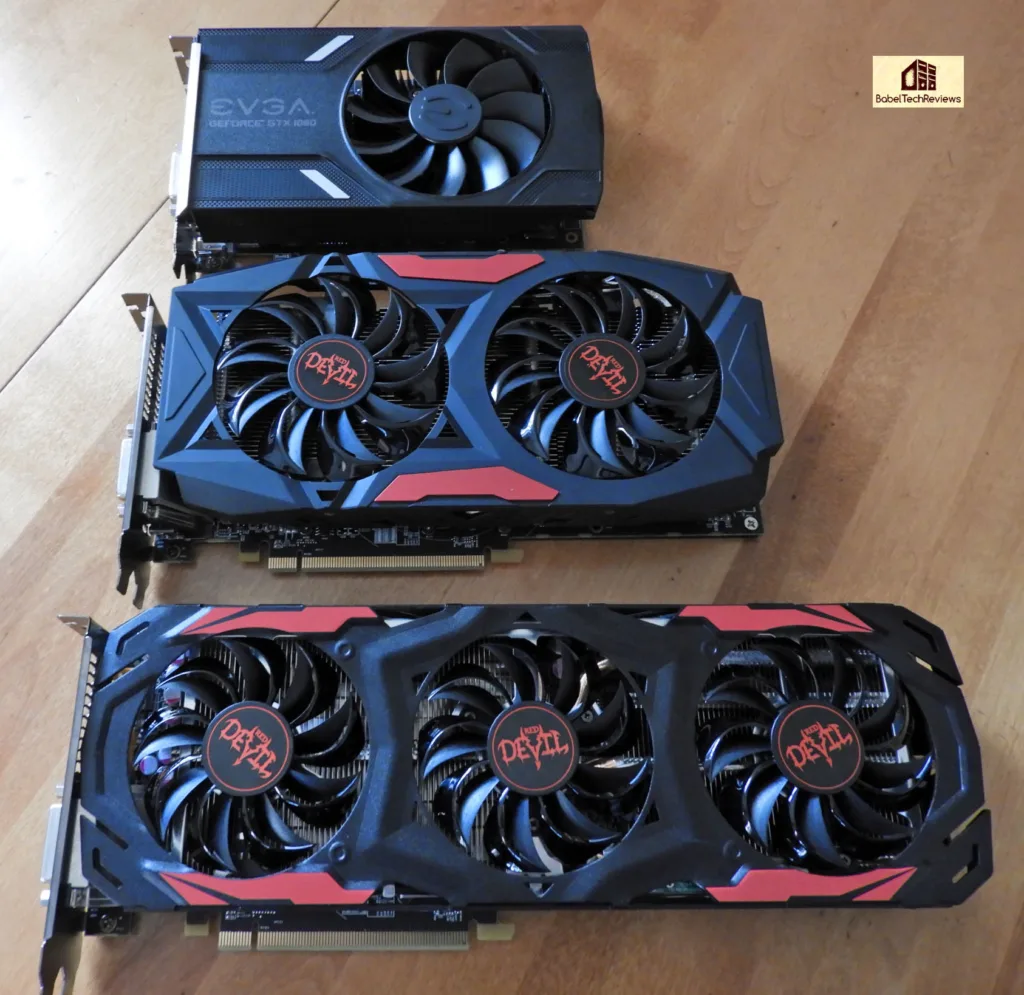
Above is pictured our testbed of 3 competing cards, and we shall test 26 games and 4 synthetic benchmarks at 1920×1080 and at 2560×1440. We have added Unigine’s brand new benchmark, Superposition, and we also now test using FutureMark’s VRMark. Our testing platform is Windows 10 Home 64-bit, using an Intel Core i7-6700K at 4.00GHz which turbos to 4.6GHz for all cores as set in the ASRock Z7170 motherboard’s BIOS, and 16GB of HyperX DDR4 at 3333MHz.
Here are the three test cards and their pricing:
- PowerColor Red Devil RX 470 4GB – at Red Devil RX 470 clocks. The card launched at $199 and can be bought now for $189.99 with a $30 mail-in-rebate
- PowerColor Red Devil RX 570 4GB – $189.99 – at Red Devil RX 570 clocks
- EVGA GTX 1060 SC 3GB, at GTX 1060 3GB reference clocks, $169.99 with a game bundle
How does the PowerColor Red Devil RX 570 4GB compare with the two other similarly priced cards?
This is the big question: How does the Red Devil RX 570 compare performance-wise with the other two cards in a similar price range?
But first, let’s take a closer look at the new PowerColor Red Devil RX 570.
A Closer Look at the PowerColor Red Devil RX 570
The Red Devil RX 570 advertises itself as a card ready for Premium VR and gaming. Also, Vulkan and DX12 support, Chill, ReLive Capture and FreeSync 2 are advertised on the front of the box.
The back of the box gives the power and system requirements which include the need for a minimum 450W power supply unit (PSU). AMD’s technology features are highlighted and the box also emphasizes the dual-blade fan technology which goes completely silent when the GPU temperatures drop below 60C. Overclocking is featured with a dual-BIOS – one for maximum overclocks, and the other for a quieter operation.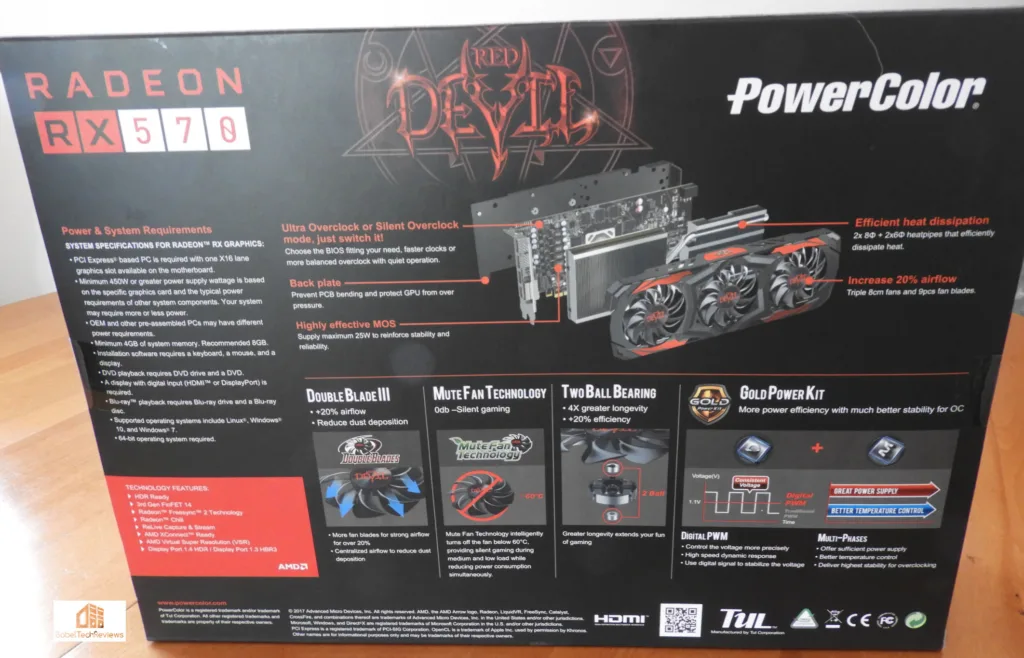
Opening the box, we see a quick installation guide, a driver CD and an invitation to join PowerColor’s Devil’s Club.
The Red Devil RX 570 is a large 3-fan card which is quite handsome in PowerColor’s signature black and red.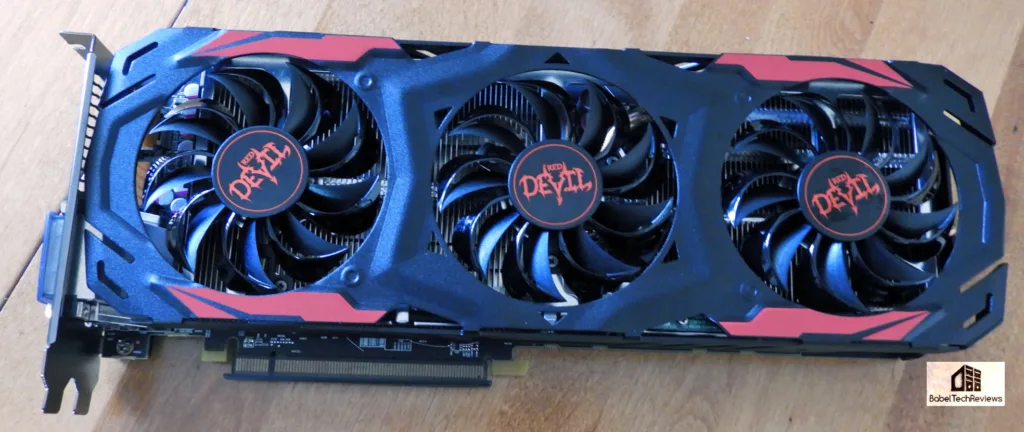
Unlike the RX 470, the PowerColor Red Devil RX 570’s sturdy backplate no longer features a hexagram inside a circle, the Seal of Solomon, although the box still does.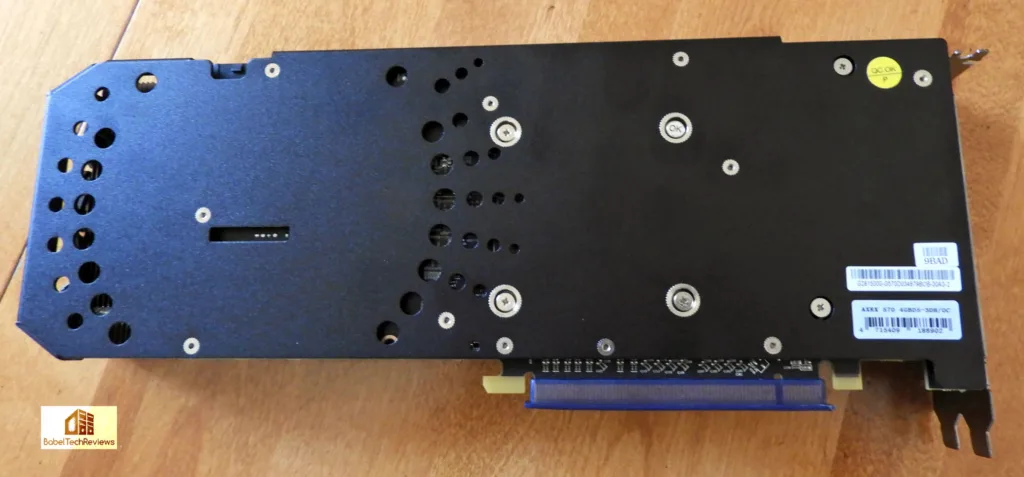 Here is a look at the Red Devil RX 570 from the edge showing its massive heatsink and 8-pin PCIe power connector. This time, the words, Red Devil are right side up when installed in a PC, unlike with the Red Devil RX 470.
Here is a look at the Red Devil RX 570 from the edge showing its massive heatsink and 8-pin PCIe power connector. This time, the words, Red Devil are right side up when installed in a PC, unlike with the Red Devil RX 470.
The Red Devil’s RX 570 connectors include 3 DisplayPorts and 1 HDMI connection and a Dual-Link DVI connector.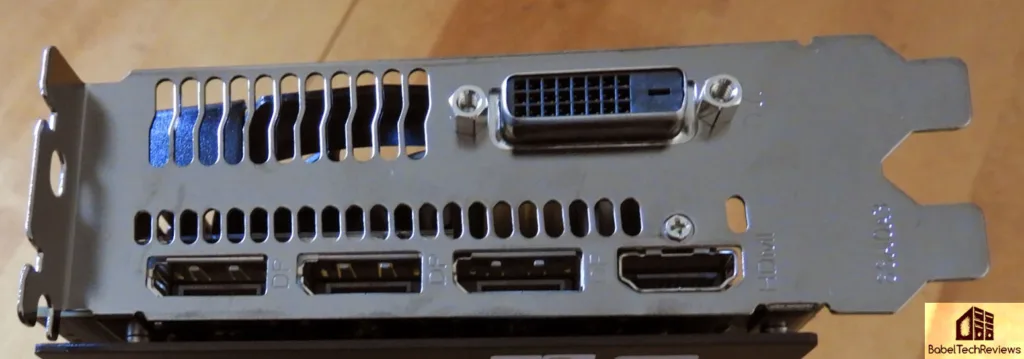 Here is a look at the Red Devil RX 570 from the other edge and we can see that the heatsink is very large.
Here is a look at the Red Devil RX 570 from the other edge and we can see that the heatsink is very large.
Here is another view with it installed in our PC.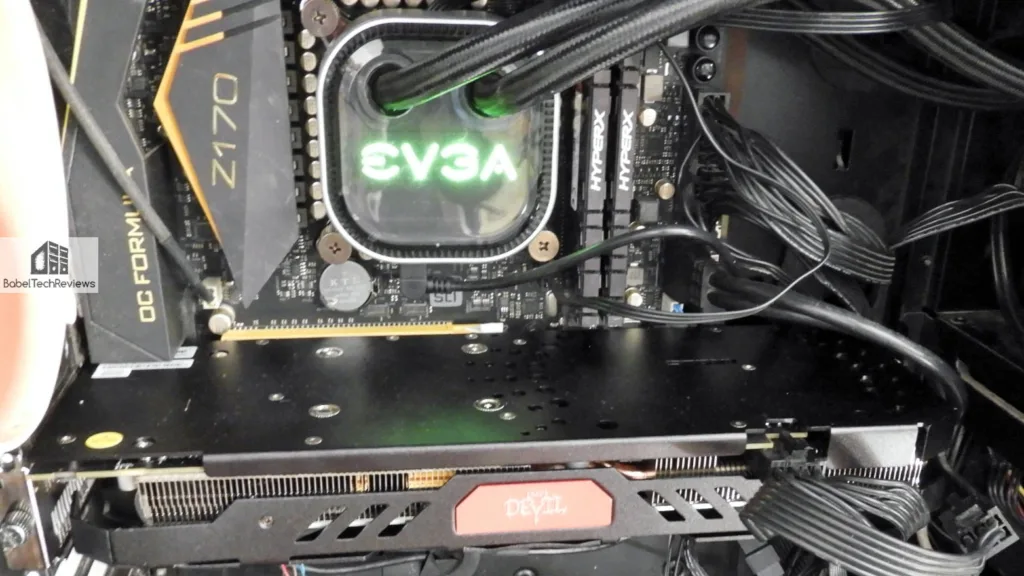 The specifications and the Red Devil RX 570 look good. Let’s check out its performance after we look over our test configuration on the next page.
The specifications and the Red Devil RX 570 look good. Let’s check out its performance after we look over our test configuration on the next page.
Test Configuration – Hardware
- Intel Core i7-6700K (reference 4.0GHz, HyperThreading and Turbo boost is on to 4.6GHz; DX11 CPU graphics).
- ASRock Z7170M OC Formula motherboard (Intel Z7170 chipset, latest BIOS, PCIe 3.0/3.1 specification, CrossFire/SLI 8x+8x)
- HyperX 16GB DDR4 (2x8GB, dual channel at 3333MHz)
- PowerColor RX 570 4GB – at Red Devil reference clocks, supplied by PowerColor
- PowerColor RX 470 4GB – at Red Devil reference clocks, supplied by PowerColor
- EVGA GTX 1060 SC 3GB, reference GTX 1060 3GB clocks, supplied by EVGA
- Two 2TB Seagate 7200 rpm SSHDs for each platform
- EVGA 1000G 1000W power supply unit
- EVGA CLC 280mm liquid cooler, supplied by EVGA
- Onboard Realtek Audio
- Genius SP-D150 speakers, supplied by Genius
- Thermaltake Overseer RX-I full tower case, supplied by Thermaltake
- ASUS 12X Blu-ray writer
- Monoprice Crystal Pro 4K
Test Configuration – Software
- Nvidia’s GeForce 381.65 drivers were used for the GTX 1060 3GB. High Quality, prefer maximum performance, single display.
- AMD ReLive Software 17.10.30 Press drivers were used for the benching both PowerColor cards
- VSync is off in the control panel.
- AA enabled as noted in games; all in-game settings are specified with 16xAF always applied
- All results show average frame rates including minimum frame rates shown in italics on the chart next to the averages in smaller font.
- Highest quality sound (stereo) used in all games.
- Windows 10 64-bit Home edition, all DX11 titles were run under DX11 render paths. The DX12 titles are run under the DX12 render path, and DOOM was run using the Vulkan API. Latest DirectX
- All games are patched to their latest versions at time of publication.
- Sapphire’s TriXX overclocking software, latest beta, was used to overclock the RX 570.
The 26 PC Game benchmark suite & 2 synthetic tests
Synthetic
- Firestrike – Ultra 4K & Extreme
- Time Spy DX12
- VRMark
- Superposition (Unigine’s latest)
DX11 Games
- Crysis 3
- Metro: Last Light Redux (2014)
- Grand Theft Auto V
- The Witcher 3
- Fallout 4
- Assassin’s Creed Syndicate
- Just Cause 3
- Rainbow Six Siege
- DiRT Rally
- Far Cry Primal
- Call of Duty Infinite Warfare
- Watch Dogs 2
- Resident Evil 7
- For Honor
- Ghost Recon Wildlands
- Mass Effect: Andromeda
Vulkan Game
- DOOM
DX12 Games
- Tom Clancy’s The Division
- Ashes of the Singularity
- Hitman
- Rise of the Tomb Raider
- Total War: Warhammer
- Deus Ex Mankind Divided
- Gears of War 4
- Battlefield 1
- Sniper Elite 4
AMD Settings
Here are the settings that we always use in AMD’s Crimson Control Center for our default benching. 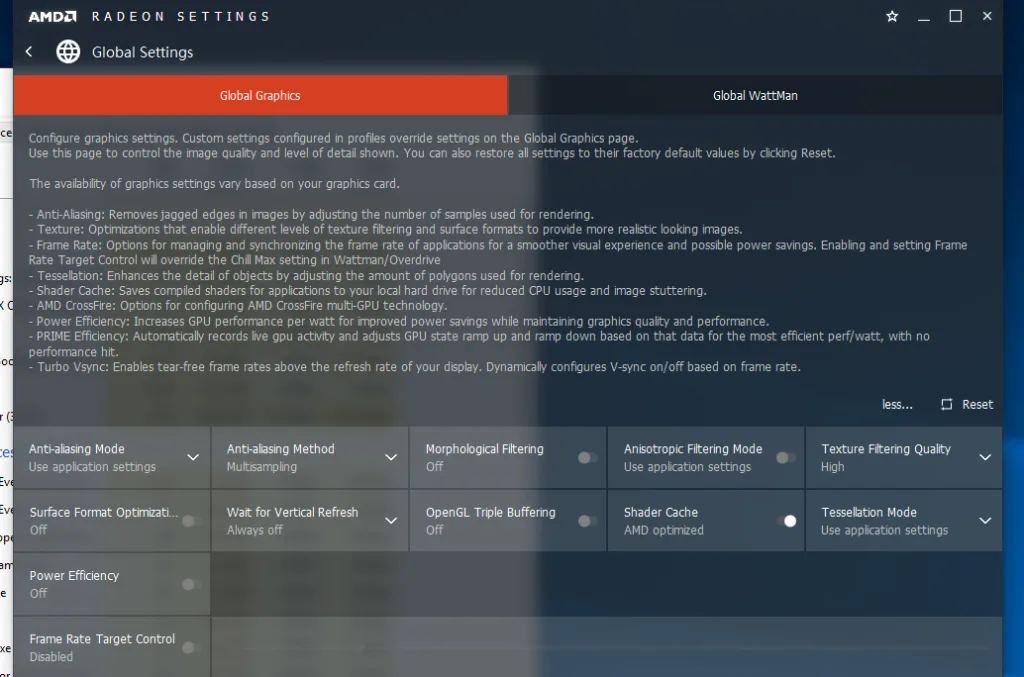
We used Sapphire’s TriXX to set the power limit to its maximum and also for overclocking.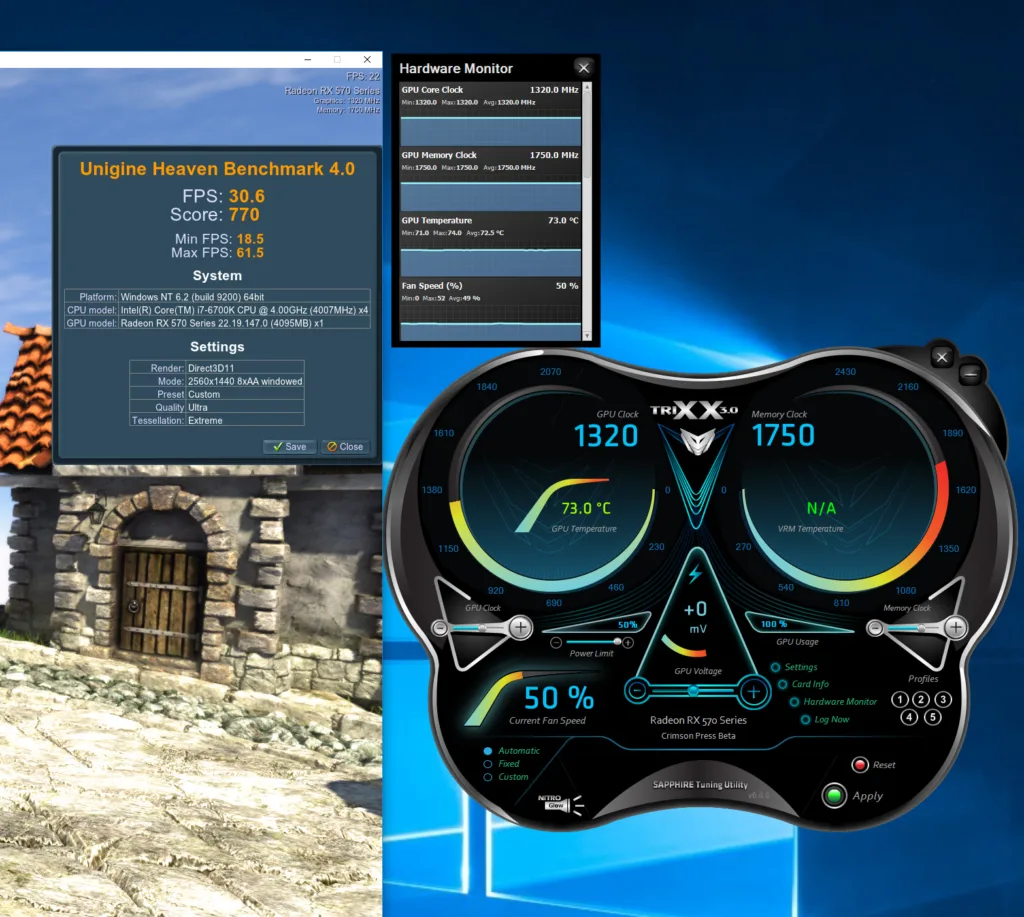 .
.
NVIDIA’s Control Panel settings:
We used MSI’s Afterburner to set the GTX 1060’s Power and Temperature targets to their maximum.
Let’s check out Red Devil RX 570 overclocking next.
Overclocking the Red Devil RX 570
We didn’t spend a lot of time overclocking the Red Devil RX 570. We used the quiet BIOS for this evaluation, but we will follow up in our next review by overclocking as far as we can go in an overclocking showdown with the GTX 1060 3GB.
Here is the screenshot of the results of looping Heaven 3.0 continuously at reference clocks.
As you can see, the clocks are locked to 1320MHz and the temperature is 73C with the fan running at 50%. Without adding any voltage using the quiet BIOS, we could only manage 1350MHz.
Next we added .48mV and overclocked further to 1370MHz.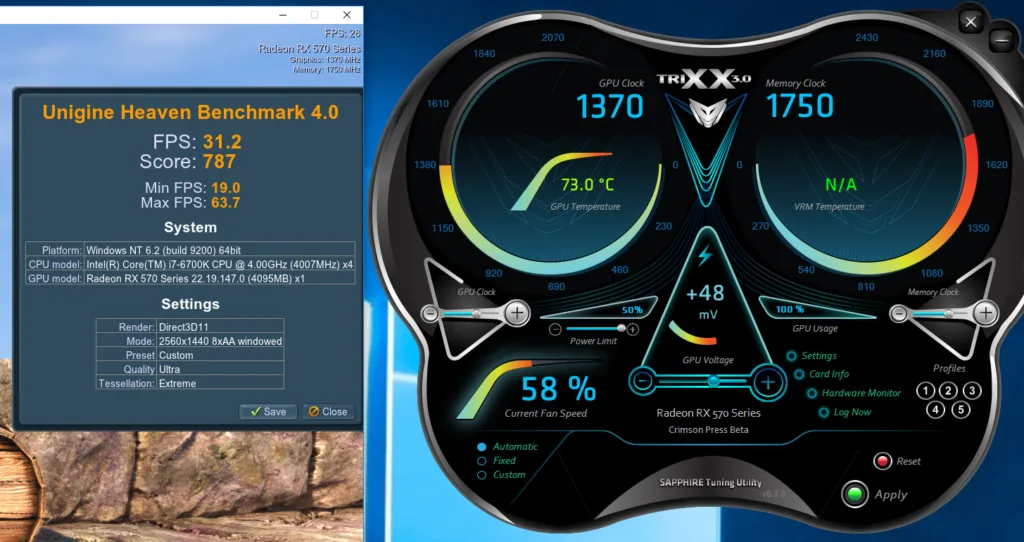
The fan rpm only went up a little to 58% and the card is quiet indeed. Unfortunately, a +50MHz offset to 1370MHz was all we could achieve using the quiet BIOS.
Let’s head to the performance charts to see how the PowerColor RX 570 at reference Red Devil RX 570 speeds compares with its two other competing cards of Spring, 2017.
Performance summary charts & graphs
Here are our performance results of 26 games and 4 synthetic tests comparing the Red Devil RX 470 4GB with the Red Devil RX 570 and versus the stock EVGA GTX 1060 3GB.
All results except for Firestrike, Time Spy, VRMark and Superposition are expressed in average fps (in Bold) and also generally in minimum fps (where they make sense, in smaller italics next to the averages). Each card is compared against the other in the adjoining results column at 1920×1080 and at 2560×1440.
The first column represents the Red Devil RX 470 4GB, the second column has the Red Devil RX 570 4GB results, and the third column shows the EVGA GTX 1060 3GB results. 
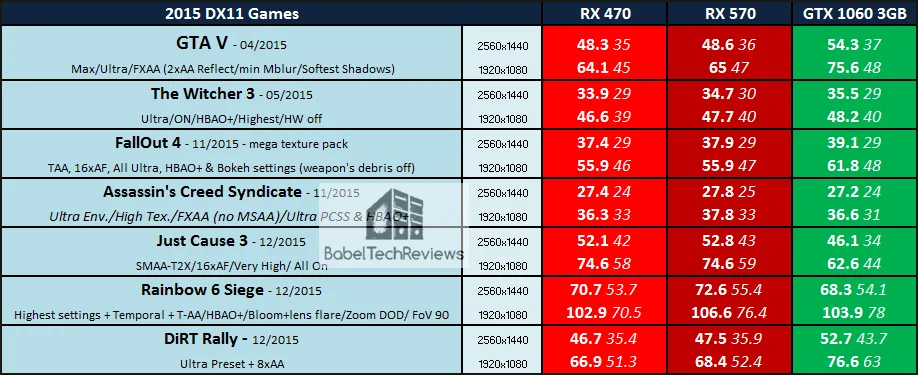
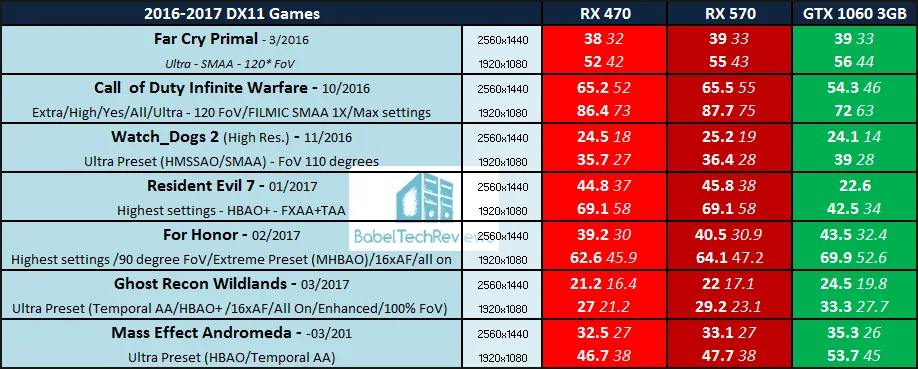
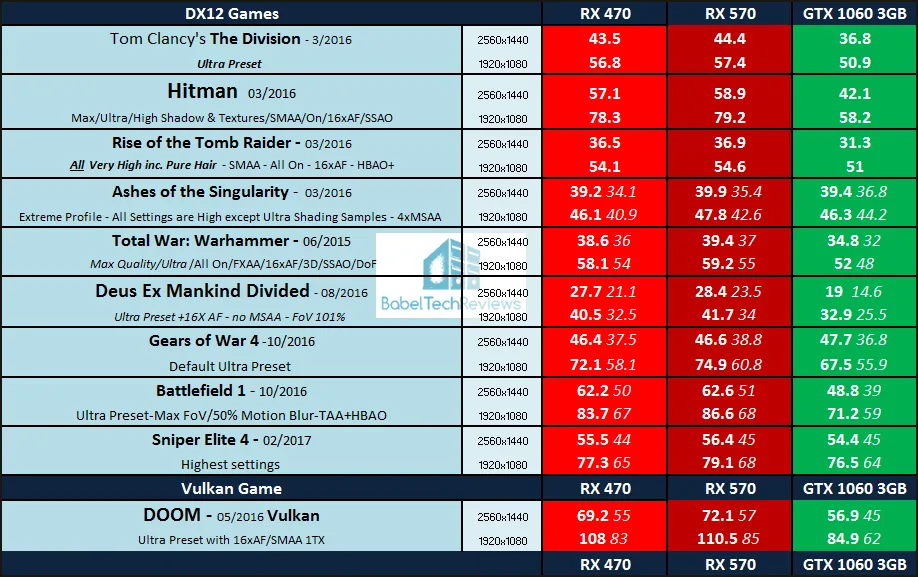 We see the Red Devil RX 470 come very close in performance to the Red Devil RX 570 since the RX 570 is clocked less than 4% higher. This time, however, the RX 570 is faster than the GTX 1060 3GB overall, winning 30 individual game benchmarks to the NVIDIA card’s 21 wins, and with one benchmark tied.
We see the Red Devil RX 470 come very close in performance to the Red Devil RX 570 since the RX 570 is clocked less than 4% higher. This time, however, the RX 570 is faster than the GTX 1060 3GB overall, winning 30 individual game benchmarks to the NVIDIA card’s 21 wins, and with one benchmark tied.
It will be interesting to see if anything changes when we overclock our Red Devil RX 570 to its maximum and pit it against the overclocked GTX 1060 3GB in our next overclocking showdown.
Let’s head for our conclusion.
The Conclusion
The Red Devil RX 570 improves slightly over the Red Devil RX 470, but it is just enough to win nearly two-thirds of the benches to the GTX 1060 3GB card’s just over one-third when all video cards are at stock speeds. The Red Devil RX 470 would be a very good deal at $189.99 with a 30 dollar mail-in-rebate if it can be found in stock. And although the EVGA GTX 1060 3GB is slower than the Red Devil RX 570 overall at stock settings, it is also only $169.99 with a popular game bundle. It will be interesting to see if anything changes when we max out our overclocks on each card.
Let’s sum it up:
PowerColor Red Devil RX 570 Pros
- The PowerColor Red Devil RX 570 is slightly faster than the Red Devil RX 470 by virtue of a nearly 4% higher core clock and it has better cooling.
- At $189 the Red Devil RX 570 is only $30 more than the Red Devil RX 470 if you count the mail-in-rebate, and it wins nearly two-thirds of the benches against the game-bundled $20 dollar cheaper EVGA GTX 1060 SC 3GB card.
- The Red Devil RX 470 has a very nice 3-fan custom cooling design that is very quiet.
- Dual-BIOS give the user a choice of quiet and less overclocking, or louder with higher overclocks.
- FreeSync eliminates tearing and stuttering.
- RX 470 has 4GB of vRAM compared with 3GB vRAM used in the less expensive but price-competitive GTX 1060.
PowerColor Red Devil RX 570 Cons
- The only real difference between the Red Devil RX 470 and the Red Devil RX 570 is less than a 4% bump in clockspeeds making it a rebrand.
We cannot comment on PowerColor’s ultimate overclock as we did not test it yet. The Red Devil RX 570 may be a very good deal for those who game at 1080P, and it may be a very good alternative to the GTX 1060 3GB for those who prefer AMD cards and FreeSync enabled displays.
very good alternative to the GTX 1060 3GB for those who prefer AMD cards and FreeSync enabled displays.
The Verdict:
- PowerColor’s Red Devil RX 570 is solidly built and it has higher clocks out of the box than the Red Devil RX 470 and may be a better overclocker by virtue of its better cooling. It represents a solid value at $189 in our opinion and it deserves BTR’s Editor’s Choice Award as a brand new replacement for the now discontinued RX 470.
We do not know what the future will bring, but right now, the PowerColor Red Devil RX 570 brings some small performance improvements over the Red Devil RX 470, and it also beats the competing game-bundled GTX 1060 3GB card that is priced in a lower but similar price range.
NVIDIA has already responded with price cuts on competing cards and they offer a popular game bundle with the GTX 1060 3GB.
Stay tuned, there is a lot coming from us at BTR. Next up, we will continue with our Red Devil RX 570 versus GTX 1060 3GB overclocking showdown. And we will also post our review of the SmartDesk this week which is called the best standing desk in the world.
Happy Gaming!
